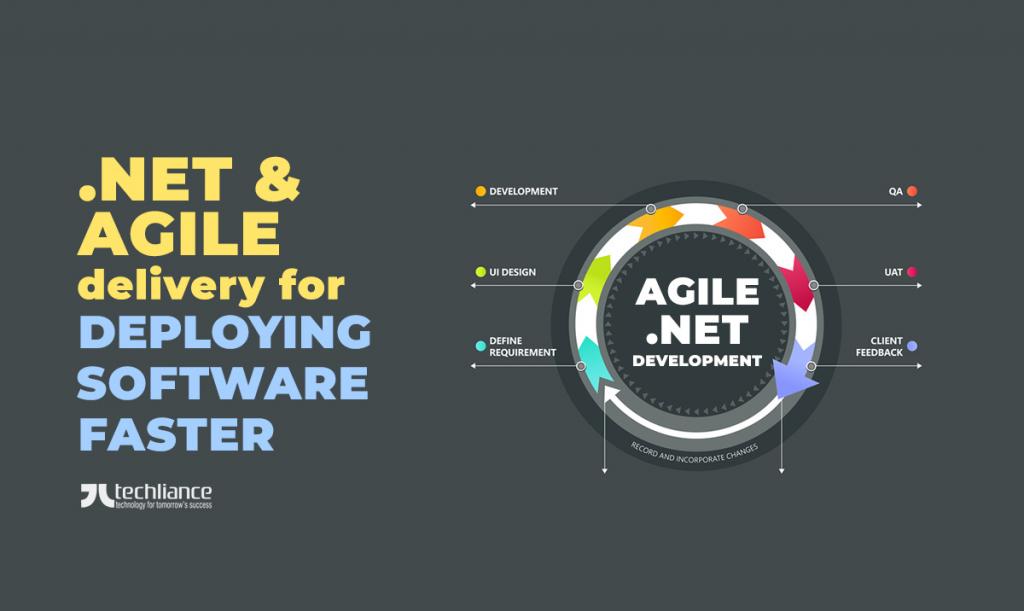Software development is just one aspect of things. Once, a software product or solution is ready, you have to launch it commercially. That’s where .NET and agile delivery enable you in deploying projects quickly.
This implies you need to deal with deployment and post-support logistics. IT operations and service delivery play such vital roles that are often forgotten in hindsight. Because companies are too busy measuring product development.
But great planning implies countering these aspects upfront. DevOps is a crucial element for faster and leaner software delivery. Accordingly, senior .NET developers take care of these relevant parts as well.

Agile and .NET combine for quicker software delivery
Ideally, everything looks good on paper until you practically implement it. The how part is what we mostly tend to undermine. Since we as running businesses happen to overlook the nitty gritty of executing the ideas.
Perhaps, the same is the case for service delivery. Although, we know what DevOps can do for software deployment. However, we often carelessly travel on this road.
The processes, operations, and governance structures in any organization need to adapt to changes. Not only within the development but also during deployment and after delivery technical support. That’s how the whole project can work properly.
Separating these functions is a pitfall that you have to avoid. The discussions between design, development, deployment, and operations need to happen simultaneously. Sometimes, companies just can’t anticipate how effective the overall product vision can get.
Everything works in perfect harmony due to collaboration. Also, this calls for building an adaptive culture that is inclusive of a Dev + DevOps mindset. Here are the advantages that .NET and agile are present for developing scalable applications.
- Two roads, one destination
- Using .NET in two-speed architecture
- A little dash of Agile
- Understanding the potential of DevOps

Let’s deliberate on these helpful aspects of .NET and agile in this article next.
Two roads, one destination
We are no longer in the era of developing large-scale mammoths of products. Even, enterprise-level software is revolutionizing with cloud computing in the background. Infrastructure is built with a broader emphasis on software integration, modularity, and scalability.
Just think about APIs and microservices. Realize how strongly they are impacting the way products are now built. Even, they play a part in the deployment of products and solutions.
Anyways, it depends on the complexity and industry of your product. What necessarily works for an eCommerce product is not the best dash ahead for an enterprise application. Hence, the differentiation causes a divide in the general school of thought.
How can you develop and deploy applications sooner if a two-team model exists? What if a conflict arises between the development and delivery teams that slows down what you deploy on production? Sometimes, benefits can ultimately become potential road blockers.

Using .NET in two-speed architecture
Keep in mind that innovative products are not coincidental. This means proper planning from the very word go is the need of the hour. As you develop a product, aim for tight integration with the hardware infrastructure.
Realize that the support team will have to work in harmony with the product team. It’s as easy as what you see is what you get. So, working with your team is a big factor in how a product is received in the market.
The market is trending with the increasing dominance of vertical enterprise-resource planning (ERP) systems. For example, SaaS, PaaS, IaaS, and other cloud-centric models. It’s time that the siloed way of working became more cohesive in removing complexity from hardware stacks.
The .NET development environment has the potential to create powerful enterprise and robust web applications. Some successful companies using the framework are Samsung, Microsoft, JP Morgan Chase, Intel, etc. Its support for Linux, macOS, Windows, iOS, and Android platforms makes it a widely usable and commercially viable framework.
Companies when developing and deploying .NET software need to pursue seamless testing, provisioning, deployment, governance, and security of services. The safest bet is to create a capabilities-based view of the IT architecture instead of a process or system-oriented view. So, showcase what your software is capable of achieving across business units (BUs), instead of a single-dimensional flow of processes.

A little dash of Agile
No software development and delivery discussion are without the mention of agile. The revolutionary methodology that is a consistent factor in product development for over a decade. Agile comes in many flavors including Scrum, Kanban, Lean, XP, etc.
Silicon Valley giants ensure that rapid development and frequent delivery of software and system updates become a norm. Eventually, the entire world grasped the idea as it favors startup and medium-scale companies too. Because of the flexibility of the agile model to develop products in a shorter time frame.
With agile, you can test the market and evaluate whether the direction works for you or not. As per the McKinney report, agile allows a wider margin for the concept of rapid development and deployment. Agile takes 17% of the original time, you usually need to deploy a product on a server.

Understanding the potential of DevOps
As part of the agile-driven deployment team, DevOps intermittently and meticulously works in the delivery of product features. That too by actively planning their tasks alongside the rest of the product team. So, the DevOps professionals build, test, and release as well as maintain products by working with the product team.
DevOps resources are also great at organizing the software infrastructure and setting up various components. For instance, servers, backup systems, branches, etc. Essentially, they manage everything which makes it easier to organize code and data.
Despite an indelible part of service delivery, many companies still undermine the value of DevOps. Only a few organizations are taking advantage of this concept for rapidly building and deploying products in the industry. However, one of the main challenges is to go through a complete transition that may require significant hardware changes.
This is probably a reason that some businesses want to avoid DevOps yet. As the capacity upgrades for DevOps cost more money. Above and beyond, DevOps positively affects the way development usually takes place in the organization.
The best course of practice is to have sounder product management and scrum master roles. Together they can most constructively overcome the problems. At day-end, you intend to provide greater features at a lesser cost, while maintaining the efficiency of the product. This is the most popular product management triage principle that leads the way forward.
DevOps experts get an additional advantage here. They can recognize which components of the system are slow and which ones are performing well. Indeed, that’s a bird’s eye view for capturing overall system efficiency, and quickly identifying what needs sorting out.

Example case: A spotlight on Netflix
One of the favorite streaming services Netflix is built on cloud IT architecture. So, the developers can work on various code branches that their DevOps team maintains. The concept of interoperability allows various code pull and merge requests to work simultaneously.
This ensures that every code is in line with best practices of development, testing, and integration. Certainly, it is a beautiful orchestration of development and deployment. If a handful of people were managing IT operations at Netflix, it would turn out quite chaotic.
But it is symbiotic with CI/CD to allow a greater magnitude of services to the users. They can access content seamlessly without ever wondering what goes behind all the intricacy. Testing is done in the production environment with a subset of users.
After the web images are live, load-balancing technology navigates part of the traffic to them from older versions. Also, there is automated monitoring to know if anything goes wrong with the new image deployment. Then, the traffic is routed back to older versions while newer images are rolled back.
Automation enables greater flexibility for Netflix to keep serving users during the deployment of new code. Whereas, other companies may take months to do the same. Plus point for companies like Netflix is that they are not inheriting a legacy system.
Such systems likely have borderline capabilities of migration to a newer infrastructure. The same goes for any product of similar capacity that instantly incorporates customer feedback. Likewise, you can put more emphasis on launching features faster so that users can enjoy better services along the way.

Conclusion
A software project is not just about developing a product or solution. Also, it involves software delivery for timely deployment. In some cases, it also includes after-deployment support.
Software delivery is not a rapid way of doing things. It is a set of processes that continuously improve with a set of best business practices across the company. Today, infrastructure as a service (IaaS) is getting increasingly popular with code porting into testing and production environments consistently.
Industry trends are more slanting towards self-sufficient teams that are ready to collaborate for smoother infrastructure-driven matters. Not just one person’s job anymore, code deployment is a responsibility that many people share. Along with automated testing, it ensures that the new code is working without any interruption of services.
The greater sense of responsibility leads to forming a collaborative company culture. The one where resources share successes, and highs instead of blaming each other for failures. Consequently, the products built using .NET and agile have higher capacity, efficiency, and usability for the consumers in the market.
Just in case, you are fed up with sub-par product development, slow deployment, and product downtime. Then, get a highly capable agile team of development and DevOps resources. Collaboratively, .NET and agile work to help you deliver successful products in the industry.
Are you looking to bridge the gap between product development and deployment? Then, it’s time to sort out your problems with DevOps and the agile approach. Discuss with Techliance and set off today.




